SHRUBS > BRUGMANSIA

Elizabeth is a Permaculture Garden Designer, Sustainability Consultant and Professional Writer, working as an advocate for positive change. She graduated from the University of St. Andrews with an MA in English and Philosophy and obtained a Diploma in Applied Permaculture Design from the Permaculture Association.
Reviewed By DAN ORI

Dan has over 27 years’ under his belt caring for plants and gardens. Working as a Horticultural Instructor and Consultant, he draws on a diverse range of experience that includes working as a Head Gardener, Tree Surgeon, Garden Centre Trouble Shooter, and writer of academic papers. Dan has a Level 3 Diploma in Horticulture and is currently a candidate for the RHS’s most prestigious award – The Master of Horticulture.
IN THIS GUIDE
BRUGMANSIA GUIDES
Brugmansia, also known as ‘Angel’s Trumpets’, is a show-stopping tropical plant.
These plants are popularly grown as ornamental plants – typically in containers.
Brugmansia are large shrubs or small trees, with large, pendulous flowers shaped like trumpets.
Overview
| Botanical Name | Brugmansia |
| Common Name(s) | Angel’s Trumpets |
| Plant Type | Shrub / Tree |
| Native Area | South America |
| Hardiness Rating | H1C |
| Foliage | Evergreen |
| Flowers | Trumpet-shaped flowers in various hues |
| When To Plant | Any time if grown indoors, Spring-Autumn if outdoors |
| When To Prune | Late summer |
Sunlight
Preferred
Full Sun or Partial Shade
Exposure
Sheltered
Size
Height
1.5 – 2M
Spread
0.5 – 1M
Bloom Time
Summer / Autumn
Soil
Preferred
Most fertile soils
Moisture
Moist but well-drained
pH
Any
Brugmansia is a genus with seven species in the Solanaceae, or nightshade family.1Angel’s Trumpets. (n.d.). iNaturalist. Retrieved March 13, 2023, from https://uk.inaturalist.org/taxa/62900-Brugmansia
Interestingly, though native to tropical regions of South America, Brugmansia is never found in natural settings, except as escapes from cultivation, and is believed to be extinct in the wild.2Pasiecznik, N. (2014). Brugmansia suaveolens (white angel’s trumpet). CABI Compendium, CABI Compendium. https://doi.org/10.1079/cabicompendium.107903
However, the genus has survived due to human cultivation and has naturalised in isolated tropical regions around the world.

They are fairly vigorous growers and can reach over 2m in height.
It is the flowers, of course, which give these plants their common name, ‘Angel’s Trumpets’.

These dramatic flowers can be up to 50cm long and 35cm wide at their largest, and they come in a wide range of different colours.
Most flowers have a strong and pleasing fragrance which is most noticeable at dusk.
A number of cultivars and hybrids of Brugmansia have been developed for use as ornamental plants.
Why Grow Brugmansia?
Brugmansia is, of course, popular due to its large, show-stopping flowers.
These flowers hang in abundance from the branches all summer long.
The flowers are appealing, not only for their appearance but also for their fragrance.
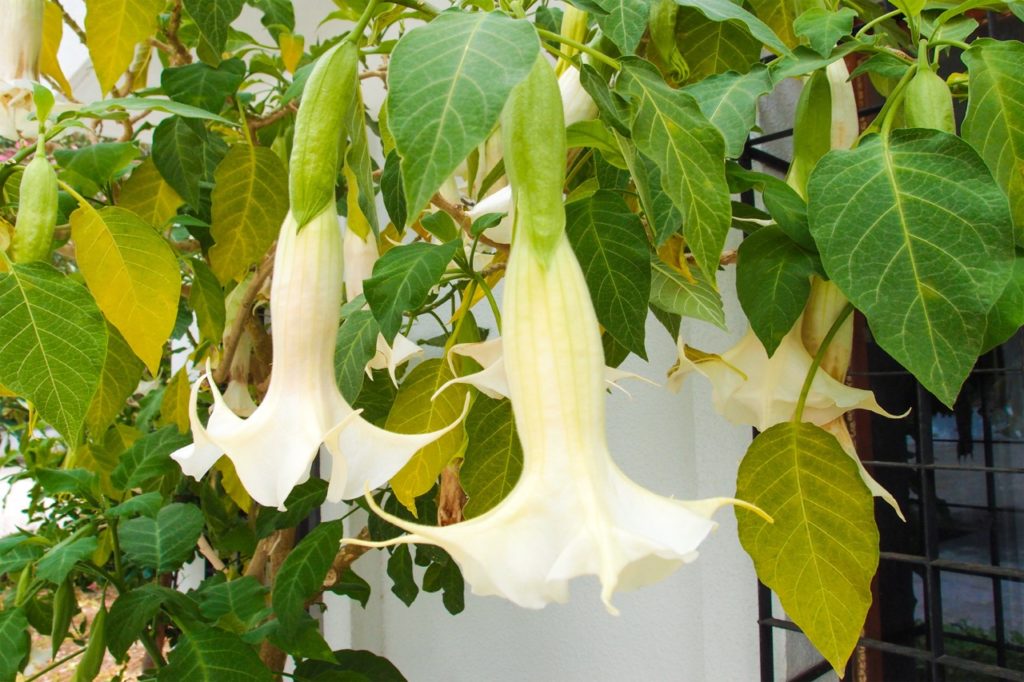
It can bring an exotic feel to a summer container garden, or to the inside of your home.
Growing Brugmansia can be a test of a gardener’s skills.
These tropical plants will need quite a lot of care and attention, but the stunning flowers and evening scent means that these are plants which can certainly reward your efforts, and you are sure to impress any visitors with a mature specimen.
Common Varieties
Recommended cultivars for UK gardeners include:
- B. x candida ‘Grand Marnier’
- B. arborea ‘Knightii’
- B. suaveolens
- B. x cubensis ‘Golden Lady’
- B. sanguinea x vulcanicola ‘Zunac 4’
Where to Grow
Brugmansia is grown in containers in the UK, and is either grown inside year-round or brought indoors over the winter months and placed outside in a sunny and sheltered spot in summer.
As a tropical plant, Brugmansia must absolutely be protected from the winter cold, as it cannot tolerate temperatures below 7-10°C.
Make sure that you also have the space to accommodate these plants which, as mentioned above, can grow rather tall.

If you plan on growing Brugmansia indoors throughout the year, they will need to be positioned in a location with plenty of bright light, such as in a conservatory, or beside a large south-facing window.
You might also grow Brugmansia in a heated greenhouse space where temperatures can be kept consistently above around 10°C.
Brugmansias can also be placed outside as soon as temperatures are reliably above around 10°C, in the summer months.
A suitable position for your container-grown Brugmansia outside will be a warm and sheltered location, in partial shade or full sun.

Planting in partial shade can be preferable because the plants will dry out less quickly in warmer weather.
One thing to note is that Brugmansia do require plenty of water, as they do not like dry conditions.
When placed outdoors in summer, they will do better in areas where there is plenty of summer rain.
In regions where summers are drier, irrigation will be crucial and you will need to pay particularly close attention to watering.

Outdoors, Brugmansia will look particularly pleasing as a focal point.
A large container with a Brugmansia will be at home in an exotic or tropical-style container garden, on a sheltered urban patio or in a courtyard garden, or in a garden with a Mediterranean feel.
They pair well with dahlias, cannas, and other exotic and bold tropical or subtropical plants.
Planting Guidelines
Note, when dealing with and planting Brugmansia, that gloves are always essential.
Brugmansias are best planted indoors between late winter and early spring, and, if you plan on putting them outdoors over the summer, only place them outdoors once nighttime temperatures are reliably above 7-10°C.
When moving the plants from indoors to outside, it is important to harden off the plants to allow them to gradually acclimatise to outdoors conditions.
Purchased Brugmansia plants should be potted up into large containers of around 60cm in diameter.
It is a good idea to choose a pot which retains water well, though there should be drainage holes to prevent waterlogging.
These pots can be filled with a John Innes No. 3 compost or equivalent.
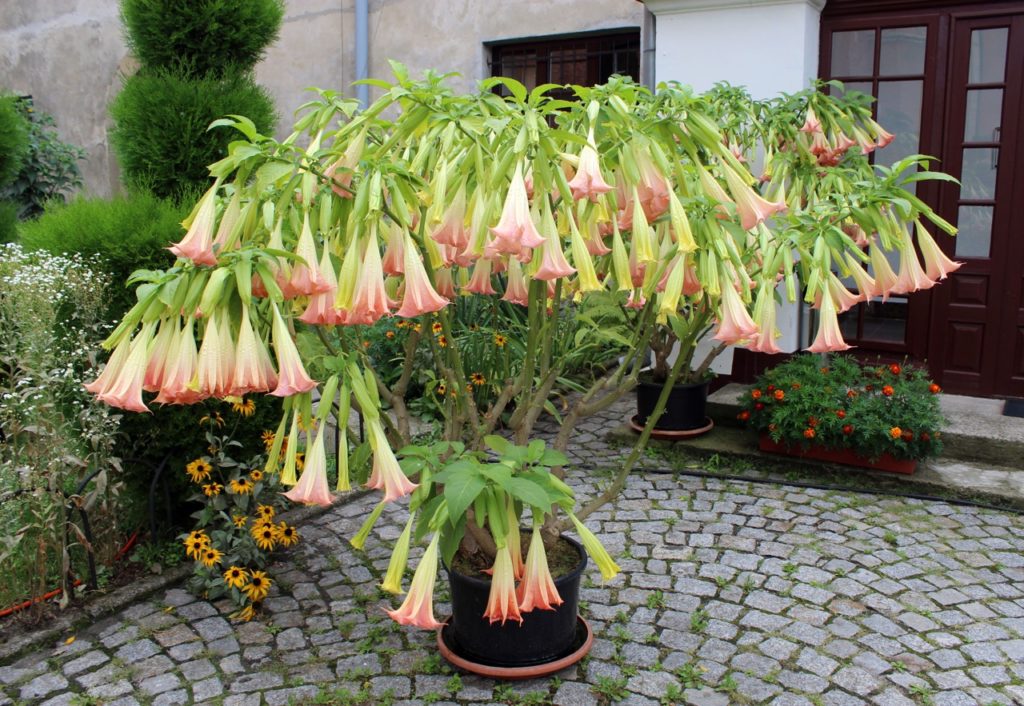
At the time of planting, it is very important to water the plants in well to ensure good establishment.
Spread an organic mulch over the surface of the pot to aid in water retention.
“What you are aiming for with your planting mix is functional water retention without waterlogging,” says Horticultural Instructor and Consultant Dan Ori.
“I have 2 planting mixes that I have had success with when growing Brugmansia.
“The first is two-parts John Innes No.3 compost to one-part horticultural grit or perlite (perlite being a favoured option as it is lighter in weight).
“The second is one-part good quality peat-free multi-purpose compost, one-part hydrated coir and one-part vermiculite.”
Ongoing Plant Care
Brugmansia are not suited to those looking for a low-maintenance option.
Watering is crucial, and not providing sufficient water is the most common problem.
However, there is a range of other crucial things to bear in mind, even when these plants are grown in an optimal location.
Watering
Brugmansia require generous watering throughout the growing season from spring to autumn.
Check compost daily and do not let it dry out.
Watering every day is usually required and you may even need to water twice a day during hot periods.
It is best to water in the early morning (and perhaps again in the evening) when temperatures are lower.
Remember, Brugmansia will need more water if grown in full sun outdoors.
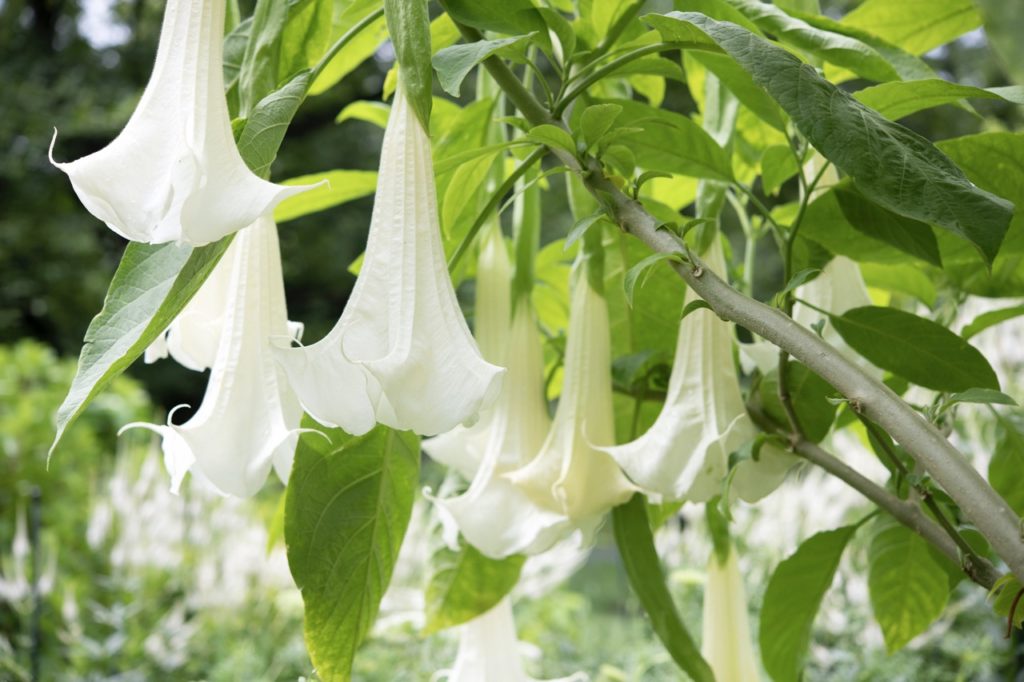
However, while Brugmansia like plenty of water, they cannot cope with waterlogging, so make sure that as well as supplying sufficient water, you also make sure that the drainage is good enough to prevent this issue.
Plants that do not receive sufficient water may well still survive, but they can lack in vigour and they may not flower as prolifically, or fail to flower at all if there are drought conditions.
Over the winter, water needs will be much lower.
You should water still, but only occasionally, since the plants will not be in active growth.
Feeding
Brugmansias, as vigorous plants, need plenty of nutrition to grow well.
It is best to apply organic mulch not only for water conservation but also for slow-release fertility.
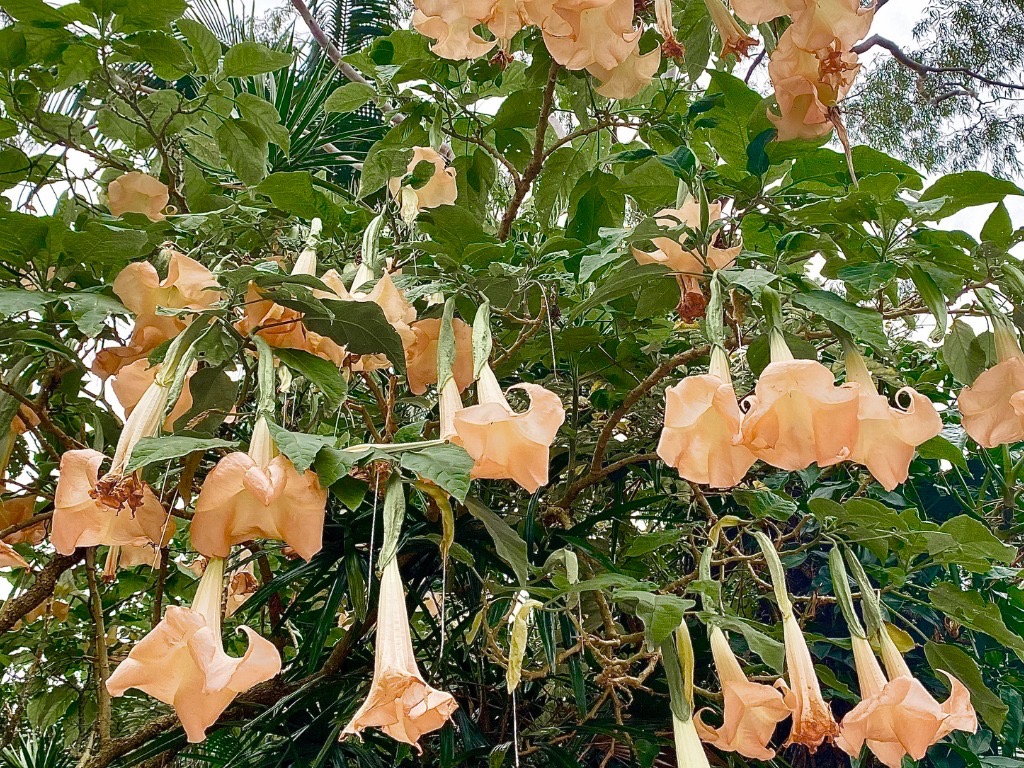
You should also feed Brugmansia once a month during the spring with a balanced organic liquid feed.
In summer, you should then switch to a potassium-rich feed and water with this at least once a week to encourage good flowering.
Winter Care
There are two options when it comes to winter care for Brugmansia.
If you have placed your Angels Trumpets outside during the summer, it is important to bring it back inside before temperatures fall below 7-10°C at night.
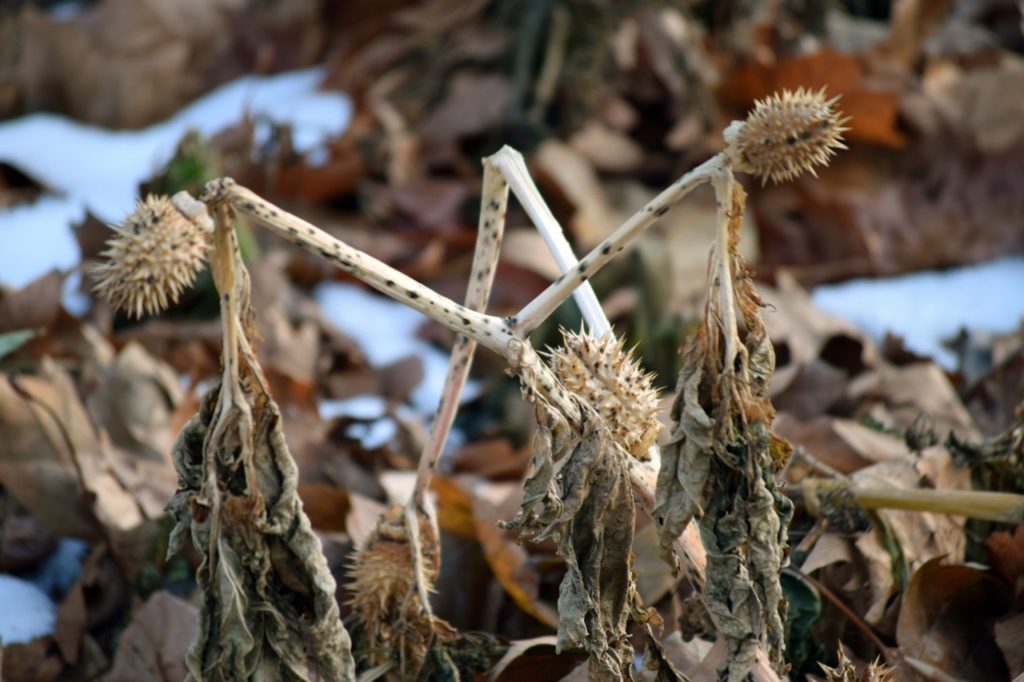
You can then choose to keep the plant in a warm bright spot, where it may even flower, or you can overwinter it as a dormant plant, placing it in a cool but not cold location with little or no light.
The plant kept dormant will lose its leaves and some of the shoots may die back, but it should recover in the spring.
Pruning
In autumn, when a plant is brought inside if it was outside over the summer, this is the time to think about pruning.
The goal is to maintain a permanent framework of branches which are healthy and well-spaced.
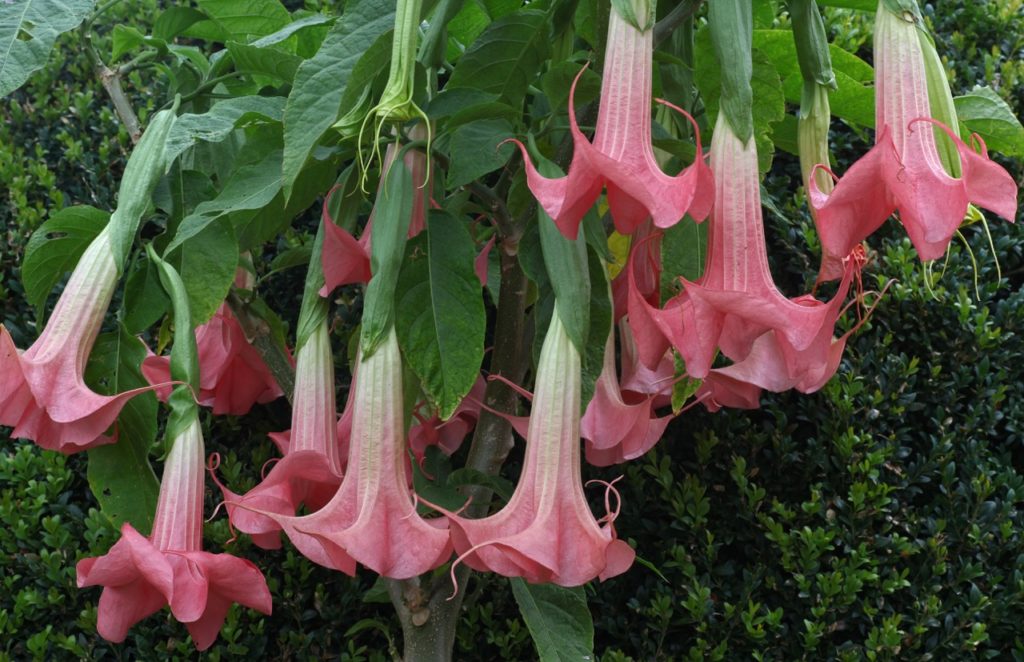
You can cut back new growth to within 2.5cm of the older wood, and may also wish to remove suckers around the base of the plant to keep it as a single-stemmed tree.
If a Brugmansia has become overgrown, these plants can also tolerate hard renovation pruning.
Propagation
If you would like to produce new Angel’s Trumpets plants from your existing one, you can do so by taking semi-ripe and softwood cuttings.
Cuttings should be around 10-15cm long and will root readily when placed into a sandy, free-draining medium with bottom heat of 18-21°C in spring, or in the late autumn.
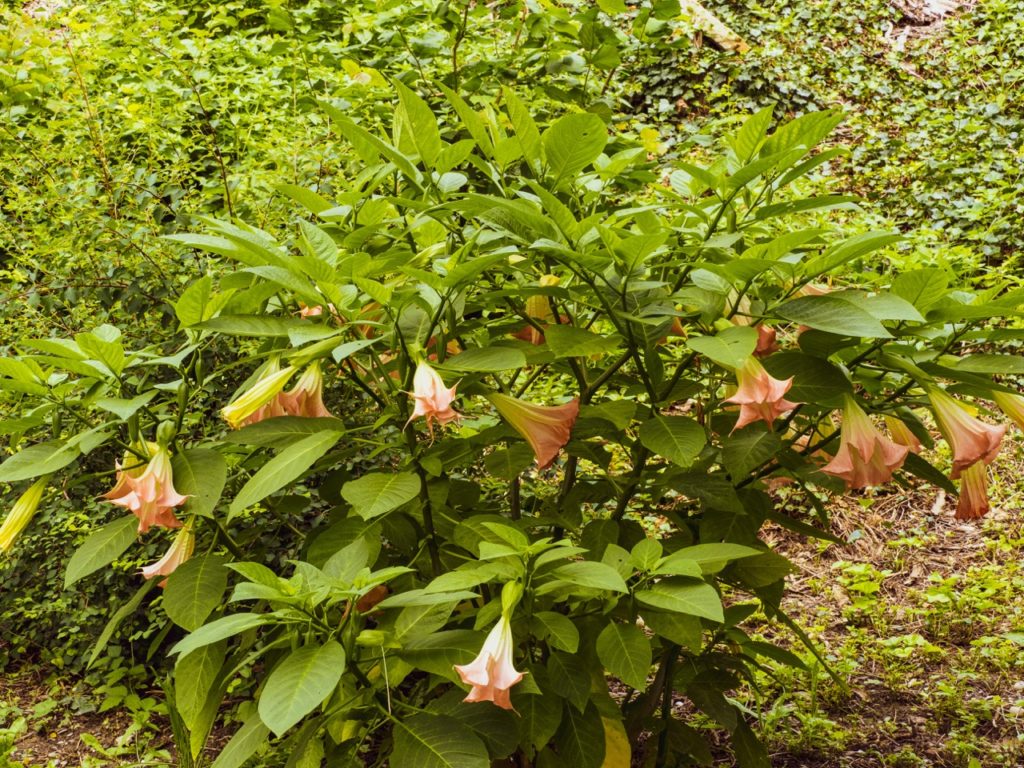
Seeds can also be sown in spring in a heated propagator providing temperatures of around 16°C.
As mentioned, however, both cuttings and seeds will take quite some time to become plants of flowering size.
Repotting
Brugmansia should be repotted into a slightly larger container every 3-4 years.
Failing to repot may cause issues.
Common Problems
Not Flowering
If your plant is not flowering, it may simply be too small.
Brugmansia need to reach a particular size before they will start to bloom.
Once the plants form a single stem of 1m or so and start to branch out, they are usually ready to flower.

Cuttings may take 3 years or so to reach this stage, and those grown from seed even longer.
However, other issues can also cause a lack of flowering on sufficiently mature plants.
There may have been an issue with insufficient watering, insufficient feeding (particularly a lack of potassium), or the container may be too small.
Pests
Other issues that may arise when caring for a Brugmansia, particularly when growing under cover year-round, are pests.
Common pests of Angel’s Trumpets include red spider mites, whitefly and mealybugs.
Organic pest control largely involves remaining vigilant, and manual removal of pests when they are noticed.
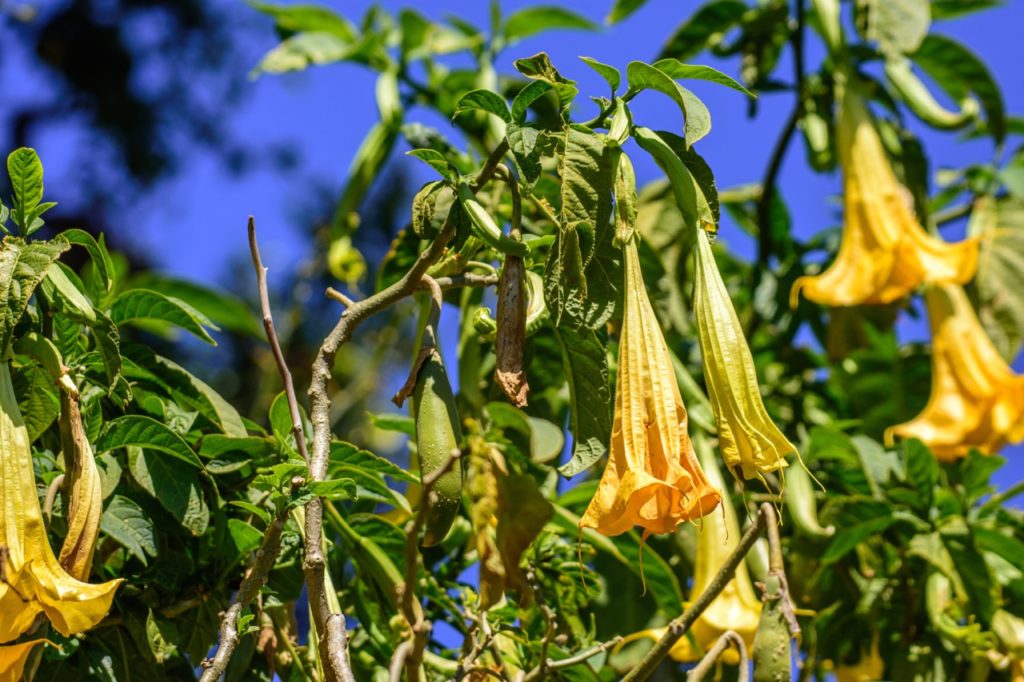
Organic sprays may sometimes be required for serious infestations, and biological controls might be considered in a greenhouse.
Brugmansia are not the easiest plants to grow, but they could be a good challenge for more experienced gardeners or houseplant owners to take on – and when cared for correctly, they can provide you with beautiful flowering displays each summer for many years to come.
References
- 1Angel’s Trumpets. (n.d.). iNaturalist. Retrieved March 13, 2023, from https://uk.inaturalist.org/taxa/62900-Brugmansia
- 2Pasiecznik, N. (2014). Brugmansia suaveolens (white angel’s trumpet). CABI Compendium, CABI Compendium. https://doi.org/10.1079/cabicompendium.107903

